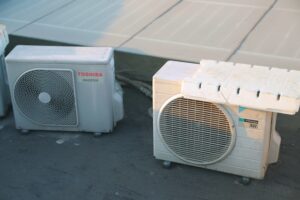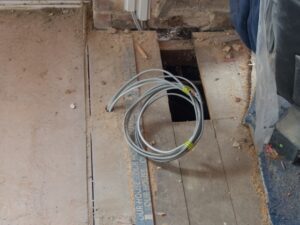Have you ever wondered what materials are behind the natural gas flowing into your home or business?
When it comes to natural gas piping, choosing the right material isn’t just about efficiency – it’s about safety, longevity, and peace of mind.
After all, your piping system plays a crucial role in keeping things running smoothly, and knowing what’s inside your walls can help you make better decisions.
The most common materials used for natural gas piping include steel, copper, and high-density polyethylene (HDPE).
If you’re tackling a renovation, replacement, or new installation, understanding the materials you’re working with is the first step in ensuring you make the right choice.
At Excel Mechanical, we’ve seen it all, and we know that when you make informed decisions about the materials used in your gas piping, you’re investing in both safety and value.
In this blog, we will walk you through:
- The most common materials used for natural gas piping and why they matter to your home or business.
- How the components of a gas piping system work and why choosing the right one is essential.
- Maintenance tips and common issues you can easily avoid, saving you from expensive repairs down the road.
Ready to dive in?
Let’s get started and explore how choosing the right materials can make all the difference in keeping your space safe and efficient!
Types of Natural Gas Piping Materials
When it comes to natural gas piping, the material you choose isn’t just about durability – it’s about ensuring the safety and efficiency of your entire system.
So, how do you pick the right material for the job?
Don’t worry; we’re here to break it down for you, highlighting the pros and cons of each option so you can make the best decision for your space.
Whether you’re installing gas lines in your home or handling a commercial project, understanding the material options available will help you get the most out of your investment.
Let’s dive in!
Metallic Gas Piping Options
- Stainless Steel is highly resistant to corrosion, making it suitable for indoor and outdoor applications. It is often used for flexible connections due to its durability.
- Galvanized Steel pipes are coated with zinc to prevent rust. They are robust and effective for transporting natural gas but can corrode over time if the coating wears off.
- Black Iron pipes are standard in natural gas distribution. They are strong and can handle high pressures, but their susceptibility to rust means they should only be used indoors.
- Copper, while not as commonly used, is sometimes employed in smaller systems. It is lightweight and resistant to corrosion. However, it can be more expensive and isn’t always ideal for high-pressure applications.
Non-Metallic Gas Piping Options
- HDPE (High-Density Polyethylene) is increasingly popular due to its flexibility and resistance to corrosion. It is often used for underground installations, as it can handle high pressure and has a long lifespan.
- PE Gas Pipe (Polyethylene) is another non-metallic option that is lightweight and easy to install. It’s mainly used for underground systems and is resistant to chemicals and corrosion.
Choosing the right piping material isn’t just about what works best in a vacuum – it’s about understanding your unique needs.
Whether you’re setting up a simple residential system or tackling a large commercial project, choosing the right material will ensure your gas system is safe, efficient, and cost-effective.
Gas Piping System Components
We’ve all heard the saying, “The whole is greater than the sum of its parts,” right?
Well, when it comes to your gas piping system, that couldn’t be truer.
Each component in the system works together to ensure your gas flows safely, efficiently, and consistently.
So, let’s dive into the key parts of a gas piping system, shall we?
Understanding how each piece functions will give you a clearer picture of how your home or business stays powered and comfortable.
Branch Lines and Drop Lines
Here’s a question – how does the gas from the main supply get to your stove, water heater, or furnace?
It’s all about the branch lines and drop lines.
Branch lines are crucial components of gas piping systems, connecting the main supply line to various appliances.
They diverge from the main line to deliver gas where it’s needed, ensuring individual appliances receive an adequate supply.
Proper sizing and installation are essential to maintain optimal pressure and flow.
Drop lines, on the other hand, direct gas from elevated areas to appliances positioned lower.
They support your system by ensuring efficient gas delivery while preventing pressure loss.
Typically, drop lines are constructed from materials like steel or flexible corrugated tubing, which makes installation manageable.
Pressure Regulators and Safety Devices
Pressure regulators are critical in maintaining consistent gas pressure within the system.
They adjust the incoming high-pressure gas from the main supply line to a lower, usable pressure for appliances. This ensures that your gas appliances operate efficiently and safely without risk of damage.
Safety devices are another important aspect, providing added protection against gas leaks or pressure anomalies.
These can include automatic shut-off valves and pressure relief valves, which engage during unsafe conditions.
Gas Piping Installation Techniques
When it comes to installing gas piping, several techniques ensure that everything is set up safely and efficiently.
You need to make sure you’re choosing the right materials, getting tight connections, and following proper procedures.
Let’s dive into the details.
Selecting the Right Materials
- Steel: Known for its strength and durability, steel is perfect for systems that need to withstand high pressure and are exposed to the elements.
- Copper: A solid option if you’re looking for resistance to corrosion, especially in residential settings. It’s not as durable as steel for high-pressure systems but is a great choice for light use.
- PVC: Lightweight and easy to handle, PVC is often used for more straightforward systems where heavy pressure isn’t a concern.
Your choice will depend on the application and local regulations, so it’s always important to weigh the pros and cons carefully.
Threading is often used for joining gas pipes.
This process creates a secure connection by cutting threads on the pipe ends.
Make sure to use the right tools and techniques to avoid leaks.
Hiring a qualified gas piping contractor is essential. They have the expertise to handle installations according to code.
Before working, ensure that all necessary permits are acquired.
This step is critical for compliance with local laws.
Once installation is underway, pressure testing is imperative.
This technique checks for leaks and verifies the integrity of the piping system.
Local Regulations and Codes
When it comes to natural gas piping, it’s not just about choosing the right material; you also need to make sure your installation complies with local regulations and codes.
These rules exist to keep everything running safely and efficiently, ensuring your gas system doesn’t pose any risks.
Here’s what you need to keep in mind:
Key considerations include:
- Material Specifications: Did you know that local codes often specify which materials are safe for gas piping? It’s not just a matter of preference! Steel, black iron, and HDPE are the usual go-to’s, but it’s always best to double-check your area’s specific rules before making a choice. Getting this right can avoid future headaches.
- Pressure Standards: Not all piping systems can handle the same pressure levels. That’s why regulations often require gas piping components to meet specific pressure standards. Ensuring your piping is built to withstand the right pressure isn’t just about following the rules – it’s about safety. Always check local guidelines to ensure your system meets these requirements.
- Piping Identification: Here’s something you might not have thought about: gas pipes need to be clearly marked. Exposed pipes usually have to be labeled with a yellow tag that says “Gas.” This is essential for safety and helps prevent accidents. Make sure all the right markings are in place during your installation.
Ignoring these regulations can be costly, both in terms of safety and potential legal issues.
Regular inspections and staying on top of these codes will not only protect you but also ensure your system functions smoothly.
When you’re ready to install or upgrade your gas piping system, you can trust Excel Mechanical to do it right.
We know how important it is to comply with local codes and regulations, and we’re committed to delivering top-quality service that fits your budget and needs. Whether you’re a homeowner or managing a commercial property, we’ve got you covered.
Common Issues and Maintenance of Gas Piping
Gas piping systems, while essential for providing energy to your home or business, aren’t immune to problems.
Understanding the common issues that can crop up, and knowing how to maintain your system, is the key to avoiding costly repairs and ensuring everything runs smoothly.
So, let’s dive into some of the most common gas piping problems and how to prevent them:
Common Problems
- Gas Leaks: Leaks are a significant concern. They can occur due to corrosion, damaged fittings, or poor installation. Regular checks are essential to ensure safety.
- Pressure Issues: Inadequate pressure can hinder gas flow. Monitor your system regularly to maintain optimal performance.
- Material Degradation: Different materials, such as flexible corrugated stainless steel tubing, may degrade over time, leading to failures. Assess your piping regularly for wear and tear.
Maintenance Tips
Now, let’s talk about how you can prevent these issues and maintain your gas piping system properly:
- Regular Inspections: Schedule inspections with professionals. Excel Mechanical offers high-quality HVAC and plumbing services tailored to your needs.
- Leak Detection: Use soapy water or gas leak detectors to find leaks quickly. If you suspect a leak, contact experts immediately.
- Cleanliness: Keep the area around the gas piping clean and free from debris. This helps prevent accidental damage.
- Professional Servicing: Regular maintenance by qualified professionals ensures your system operates efficiently.
In the long run, paying attention to these maintenance tips will help you avoid costly repairs and ensure the safety and efficiency of your gas piping system.
After all, a well-maintained system means less worry and more peace of mind!




